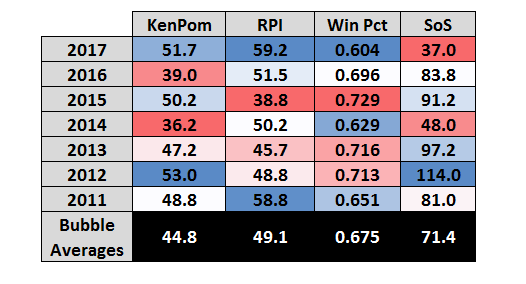Is the 2017 Bubble Really the Weakest in Years?
Posted by Shane McNichol on March 2nd, 2017One of the prevailing narratives that has developed during the second half of this season is the existence of a historically weak crop of bubble teams. The bubble, by its very definition, is a fluid concept where a 68-team field consisting of 37 at-large teams necessarily limits the strength of the group. For whatever reason, though, this season’s bubble dwellers have earned a reputation as a particularly futile bunch. To explore the veracity of that claim, I reviewed the last seven NCAA Tournament bubbles (2011-17). This includes every NCAA Tournament since the 2011 implementation of the First Four, which added three additional teams to the at-large field. For this year’s bubble, I used ESPN bracketologist Joe Lunardi’s Last Four In and his first two out from the bracket released on Monday, February 27 — teams included were USC, Providence, Marquette, Vanderbilt, Georgia Tech and Wake Forest.
There are several clear takeaways here. First, the 2017 bubble does in fact feature the worst aggregate winning percentage and average RPI of the last seven years, along with the second-worst average KenPom ranking. In comparison with the last six years, this group of six bubble teams is statistically weaker than other years relative to the higher levels of automatic qualifiers. The most important finding, though, can be found in the far right column. This season’s bubble teams have all played very difficult schedules, nearly cutting the average bubble member’s strength of schedule rating in half. That’s notable because this season’s six bubble teams are from power conferences, while 19 of the 36 bubble teams from 2011-16 came from the mid-major world. That group included schools like Middle Tennessee, Tulsa, Colorado State, Iona, BYU (twice), Boise State (twice) and Oral Roberts.
This season’s bubble may feature a number of teams with less impressive resumes than years past, but it also appears that the selection committee’s continued admonition about soft scheduling has taken root. The teams on this year’s bubble, at least those defined as such by Lunardi and others, have played difficult schedules with only middling success. This explains why we see so many teams with strong schedules but average records. Before last night’s win over Louisville, Wake Forest’s 16-12 record included just one quality win over Miami (FL). Providence’s 19-11 record includes just two high-value wins over Butler and Creighton. Vanderbilt own wins over Florida and surging Iowa State but not much else.
Bid thieves over the next 10 days could also throw a wrench into this scenario. If teams like Illinois State/Wichita State in the MVC, Gonzaga/Saint Mary’s in the WCC, VCU/Dayton in the Atlantic 10 and Middle Tennessee in Conference USA fail to win their conference tournaments, the bubble teams will necessarily drop in the queue. Then we’ll see if the committee is truly committed to rewarding stronger schedules or if overall wins are still king. In the power conference tournaments, teams sitting on the bubble should have more chances to play each other as well as pick up more quality wins against the better teams in their league. But failing to collect at least one more signature win before Selection Sunday could become a death sentence for teams sitting on the fence as of today.














































